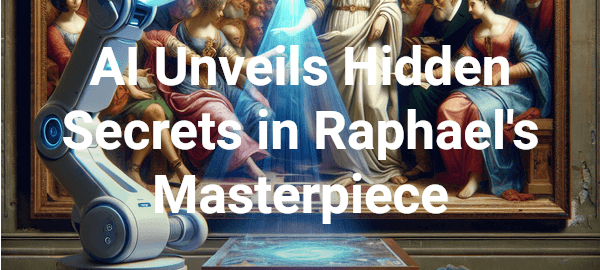Art lovers, prepare to be amazed: artificial intelligence has just cracked a centuries-old mystery!
In a shocking twist, artificial intelligence has once again proven its worth in the art world. This time, it’s uncovered a hidden detail in a famous Raphael masterpiece that has eluded human eyes for centuries. It’s not the first time AI has revolutionized our understanding of art, as we’ve seen in the AI-driven digital renaissance sweeping through galleries worldwide.
As a musician and tech enthusiast, I’ve always been fascinated by the intersection of art and technology. I remember the first time I used AI to analyze one of my compositions – it revealed harmonies I hadn’t even consciously included! It’s thrilling to see this technology now unraveling the mysteries of classical art.
AI’s Keen Eye Uncovers Raphael’s Secret
In a groundbreaking discovery, artificial intelligence has detected a mysterious detail hidden in a famous Raphael masterpiece. This revelation showcases the power of AI in art analysis, potentially revolutionizing how we study and interpret historical artworks.
While specific details about the discovery are currently limited due to access restrictions, the implications are profound. AI’s ability to detect nuances invisible to the human eye could unlock countless secrets in art history, providing new insights into artists’ techniques and intentions.
This breakthrough demonstrates the growing synergy between technology and the humanities. As AI continues to evolve, we can expect more such revelations, potentially rewriting our understanding of art history and opening new avenues for research and appreciation.
ArtificiART: Unveiling History’s Hidden Treasures with AI
Imagine a startup that combines artificial intelligence with art conservation and analysis. ArtificiART would offer museums and private collectors a revolutionary service: AI-powered scans of artworks to uncover hidden details, authenticate pieces, and assist in restoration. The company would develop proprietary AI algorithms tailored for different art periods and styles. Revenue streams could include scanning services, software licensing to major institutions, and exclusive art history publications revealing new discoveries. This blend of cutting-edge technology and classical art could revolutionize the field of art history and preservation.
Embracing the AI Art Revolution
As we stand on the brink of this AI-powered art revolution, the possibilities are both thrilling and endless. What other secrets might be hiding in plain sight, waiting for AI to unveil them? How will this technology reshape our understanding of art and history? The journey of discovery is just beginning, and you can be part of it. Are you ready to see the world’s masterpieces through AI’s eyes?
FAQ: AI in Art Analysis
- Q: How does AI analyze artwork?
A: AI uses advanced image recognition and machine learning algorithms to detect patterns, brush strokes, and hidden details that may be imperceptible to the human eye. - Q: Can AI replace art historians?
A: No, AI is a tool to assist art historians, not replace them. It provides new insights that experts can then interpret and contextualize. - Q: What other applications does AI have in art?
A: AI is also used in art restoration, forgery detection, and even in creating new artworks, expanding the boundaries of artistic expression.
